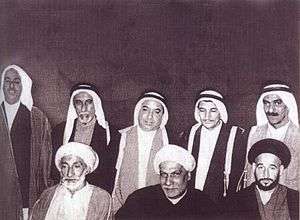National Union Committee

Part of a series on the |
|---|
| History of Bahrain |
 |
|
Reigning Dynasties
|
|
|
The National Union Committee (Arabic: هيئة الاتحاد الوطني) was a nationalist reformist political organization formed in Bahrain in 1954 (originally named the Higher Executive Committee, Arabic: الهيئة التنفيذية العليا). The committee was formed by reformists in response to sectarian clashes between Sunni and Shia members of the population. The original aims were to push for an elected popular assembly, a codified system of civil and criminal law, the establishment of an appellate court, the right to form trade unions, an end to British colonial influence (through the removal of Charles Belgrave), and an end to sectarianism.
The original committee was made up of four Sunni representatives and four Shi'i representatives. The members were:
- Abdulrahman al Bakir (Arabic: عبدالرحمن الباكر) - Secretary
- Abdulaziz al Shamlan (Arabic: عبدالعزيز الشملان)
- Ibrahim Fakhro (Arabic: إبراهيم آل فخرو)
- Ibrahim bin Mousa (Arabic: إبراهيم بن موسى)
- Abdali al Alaiwat (Arabic: عبدعلي العليوات)
- Sayyid Ali Kamaluddin (Arabic: السيد علي كمال الدين)
- Shaikh Abdullah Abudeeb (Arabic: الشيخ عبدالله ابو ديب)
- Shaikh Mohsin al Tajir (Arabic: الشيخ محسن التاجر)
Arrest and deportation
The NUC successfully orchestrated a number of general strikes and demonstrations in the country to push for its demands. In March 1956, British Foreign Secretary Selwyn Lloyd was visiting Bahrain. Crowds of protesters lined the streets to shout anti-British slogans and threw sand at stones at the Foreign Secretary's entourage. A number of crew members, including a stewardess, were left injured. Abdulrahman al Bakir, the secretary of the NUC, was among the leaders of the demonstrations. He was asked to leave the country after the incident for an extended stay abroad, and departed to Egypt. Al Bakir returned to Bahrain September 1956.
In October 1956, the NUC called for strikes and demonstrations against the Israeli-Anglo-French attack on Egypt in the Suez Campaign. This led to days of violence in Bahrain. In November, the ruler Shaikh Salman ibn Hamad Al Khalifa (1895-1961), ordered the arrest of the NUC leaders, accusing Al Bakir, Al Shamlan and Aliwat of attempting to take his life. A specially set up court in Budaiya made up of three judges (all members of the ruling Al Khalifa family) tried the men and found them guilty. They were sentenced to 14 years at a prison located outside of Bahrain, in Saint Helena.
In June 1961 the three prisoners were released from Saint Helena after a successful habeas corpus action, and were later paid financial compensation from the British government.
References
- Debates in British House of Commons
- Miriam Joyce. The Bahraini three on St. Helena, 1956-1961 in The Middle East Journal. Washington: Autumn 2000. Vol.54, Iss. 4; pg. 613
- Falah al-Mdaires. Shi'ism and Political Protest in Bahrain in Domes. Spring 2002. Vol. 11, Iss. 1; pg. 20
- Khalaf, Abdulhadi (1998). Contentious politics in Bahrain: From ethnic to national and vice versa.
- Fuad Ishaq Khuri (1980). Tribe and state in Bahrain: The transformation of social and political authority in an Arab state. ISBN 0-226-43473-7
- Fred H. Lawson (1989). Bahrain: The Modernization of Autocracy. ISBN 0-8133-0123-8
- Charles Belgrave, Personal Column, (London: Hutchinson,1960)
- Abdulrahman al-Baker, (1965) Mina al-bahrayn ila al-manfaa, 'sant halaneh', [From Prison to Exile 'Saint Helene'], al-Hayat Library Publications, Beirut.
- Bahrain: The Ruling Family of Al Khalifah, A. de L. Rush, Archive Editions, 1991
- Readings in the trial of the National Union Committee leadership, Hussain Al Baharna (Arabic)
- The National Union Committee in foreign writings, Abdulnabi Al Ekri, Feb 2005
- Bahrain Nationalist Movement in Encyclopedia of the Modern Middle East and North Africa
- National Liberation Front (Bahrain) in Encyclopedia of the Modern Middle East and North Africa]